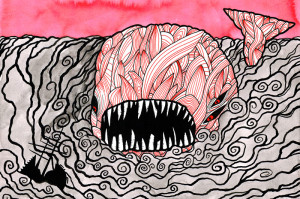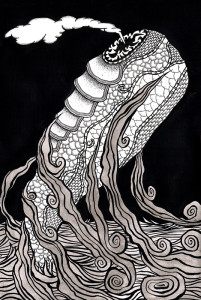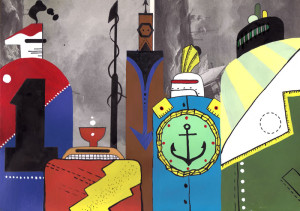THE whale was never just a whale. After 160 years, there is still no end to the meanings read into Moby-Dick, and the titular monster prevails as symbol for anything and everything that we doubt or dread, including existence itself, and whatever something or nothing that might lie beyond. From Matt Kish’s point of view as an illustrator, this made Herman Melville’s “damned whale” extremely tricky to draw.
“All these questions about Moby-Dick,” says Kish. “Is he real? Is he more than a dumb brute animal? Is he the word of God made flesh? Is he karmic punishment for Captain Ahab’s sins? I had to draw him in such a way that each of those perceptions was only one of many possibilities.” The results can best be seen on page 534 of Kish’s new book Moby-Dick In Pictures, when the white whale finally breaches at the climax of the story.
It took Kish more than 16 hours to render this moment in ink on watercolour paper, which is the longest and hardest he worked over any single image in the course of his own monumental quest to illustrate Melville’s epic, mythic text at a mad rate of one picture, per page, per day. Beginning in August 2009 with a copy of the Signet Classics paperback edition, he finished earlier this year, after 552 days of drawings. “I wish I had done a bit more planning beforehand,” he says, “because I soon found some other editions that were closer to 350 pages.I could have saved myself 7 or 8 months of work. But by then I had already started … ”
The basic idea was not quite unprecedented. A decade ago, the punkish American painter Zak Smith took it on himself to make a new piece of art for every page of Thomas Pynchon’s novel Gravity’s Rainbow, each picture painstakingly literal in drawing out hysterical visions from the prose. “I was always in awe of that project,” says Kish. “Not just the ambition, but how well it was done.” Unlike Zak Smith, he had no formal training.
Born to “filthy hippies” in 1969, Kish grew up in Cleveland, Ohio, among the most depressed of US industrial cities. His taste in art, and the first hints of his style, he picked up from the jackets of his father’s science-fiction paperbacks, and the prog-rock double-LP sleeves of the period. “I remember being surrounded by all these amazing covers, these gorgeous paintings of fantastic and surreal worlds.” Around the same time, at the age of five or six, he saw John Huston’s 1956 film version of Moby-Dick, with Gregory Peck as Ahab, when it came on TV one Saturday, directly after a daytime run of old Godzilla movies. “It looked so real by comparison,” says Kish. “These were real people and real ships, and here you had this giant white whale, this monster that must be real too.” “I talked about it so much that my parents gave me this little abridged edition of the book, which I re-read dozens of times. I was so fixated on the whale that I don’t remember how I visualised Ishmail [the narrator], or even the Pequod [Ahab’s ship]. It was always the whale.”
Kish went on to read it unabridged in high school, and found himself bored by long stretches of the voyage – the passages of rumination on whaling, the sea, and the cosmos, all Melville’s digressions from the chase. It’s a common reaction, especially among the young. “This book becomes more rewarding, and more important, the more life experience you have. When you’re 13, 15, 20, 25, maybe everything is exciting. But after a few years in a soul-crushing job, you start to wonder if there’s any kind of meaning. You ask yourself some of the questions that resonate through this text from the mid-19th century.”
Kish has done a lot of jobs, not all of them soul-crushing. He used to cut the grass around a large Ohio hospital, and enjoyed it because it was “peaceful”, like Ishmail on a lawnmower. He’s also been a dishwasher, a cook, a computer lab monitor, assistant manager of a used bookshop. In his free time, he has always drawn pictures – detailed, textured sketches of “inner worlds and private mythologies” – but only for his own pleasure. He never went to art school, and doesn’t call himself an artist. “It just didn’t occur to me that you could do this for a living.”
“I thought a job had to be like a chore, and art was always fun. But some artists can be real a******s about it. If you haven’t got a degree, or had a gallery show, or made a certain income through sales, it’s like you haven’t earned the right to that title. ‘Illustrator’ seems like a safer word. People understand it. They’ve seen illustrations on the side of detergent bottles. They don’t react the same way when they hear it.” If Kish is not an artist, then he is at least prone to demented creative impulses. Feeling listless a few summers ago, his own drawings were becoming less fun and more labour-intensive, until an old friend on Facebook reminded him about his long-dormant obsession with Moby-Dick. “At that point the book itself was like a forgotten friend.”
He started this project with Ishmail in mind. “The way his narration unfolds, he becomes a more and more passive observer, almost a non-entity. He’s telling the story but he has no impact on it. By doing these illustrations, and sharing them on a blog, I thought that I could be some kind of visual Ishmail – let me show you what happened.” Kish worked mostly at night, after eight hours at his current day-job in the back office of a public library (plus a three hour round-trip commute). He pored over that day’s page of Moby-Dick during his lunch break, looking for a “phrase or idea or image” to use at home, where he then locked himself in a cupboard with his materials. Day by day the results went up on his blog, and slowly attracted notice from online design sites and literary magazines until he was offered a book contract on the strength of the work in progress. Kish was reluctant to sign it, for fear of outside influence and external pressure.
The closer he came to the end, the more he felt like Captain Ahab. “I know that sounds ridiculous,” he says. “I was getting so desperate to finish because it was the only way to see my wife and my friends and reconnect with the world. At the same time, out of sheer pride, or arrogance, or self-destructive obstinacy, I was pushing myself to make the illustrations more complex and overwhelming. Obviously, I came out of it alive, which is more than you can say for Ahab and his crew.” The completed book is a stack of strange and beautiful pictures, each one filled with colour and detail, marks and quirks, intricacies and intimations of deep feeling.
Kish takes some credit for the rough human touch of these pieces – he drew or painted them all with ink, pencils, and brushes onto sheets of “found paper” salvaged from old TV repair manuals and other abandoned books. “So much of what we see now is digitally created or finessed,” he says. “Animations, labels, magazines. I can’t stand digital art. It’s so cold. I want to see the hand of the maker.”

This last choice of words sounds almost Melvillian, and Kish defers the rest of the praise for his work to the power of the book that inspired him. “What I’ve done is actually just a footnote to the novel, or a shadow. It’s just one person’s way of looking at it. I wanted it to be my own impressions of the novel ripped out of me and presented on paper.” Translated from Melville’s language into Kish’s illustrations, nothing of the mystery is lost. “I wanted it to be unknowable,” says Kish, and it’s a testament to Moby-Dick that he might be talking about the whale, the novel, the soul, or the universe. “I want people who see these pictures to feel like they have to read the book and find out what it’s all about. But even when they do, they still won’t really know. We’ll be dead before we get to the bottom of it, and even then we might not get an answer.”


Leave a Reply